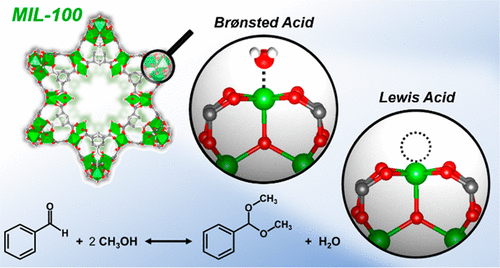当前位置:
X-MOL 学术
›
ACS Catal.
›
论文详情
Our official English website, www.x-mol.net, welcomes your
feedback! (Note: you will need to create a separate account there.)
Metal–Organic Framework MIL-100 Catalyzed Acetalization of Benzaldehyde with Methanol: Lewis or Brønsted Acid Catalysis?
ACS Catalysis ( IF 11.3 ) Pub Date : 2020-03-09 , DOI: 10.1021/acscatal.0c00399 Jacklyn N. Hall 1 , Praveen Bollini 1
ACS Catalysis ( IF 11.3 ) Pub Date : 2020-03-09 , DOI: 10.1021/acscatal.0c00399 Jacklyn N. Hall 1 , Praveen Bollini 1
Affiliation

|
Metal–organic frameworks (MOFs) are an emerging class of catalyst materials that present the opportunity to develop Lewis acid catalysts with uniform, well-defined, tunable, isolated active sites for a range of chemical transformations. A common example of such a transformation is the acetalization of carbonylic compounds with alcohols over MIL-100. Despite numerous reports focused on the acetalization performance of MIL-100 and related MOF materials, the identity of MIL-100 active sites still remains a point of contention. We present herein a range of catalytic, in situ titration and spectroscopy data that can all plausibly be interpreted under the assumption of the near-exclusive contribution of Brønsted acid sites toward effecting acetalization turnovers over MIL-100(Cr) and MIL-100(Fe). Thermal treatment protocols that simultaneously increase Lewis acid site density and decrease Brønsted acid site density can be used to eliminate more than 90% of MIL-100 mediated turnovers, and infrared spectroscopic signatures indicating the coordination of pyridine to acid sites upon sequential introduction of 2,6-di-tert-butylpyridine (DTBP) followed by pyridine, but not vice versa, are consistent with an attribution of the genesis of Brønsted acid sites to water ligation to open-metal sites. Correlations between MIL-100 degree of hydration, Brønsted acid site density, and net turnover numbers suggest that the involvement of Lewis acid sites, if any, remain minor under the experimental conditions used in this study. Lastly, a decreasing fraction of sites left unititrated by DTBP with lightening diffusion restrictions around the oxo centered trimer indicate that untitrated sites reflect limited access of sterically hindered DTBP, rather than contributions from Lewis acid sites. The principles and methodology used in this study are broadly applicable within the domain of MOF-mediated catalysis, and reinforce the need for a careful evaluation of active site speciation under reaction conditions to more fully realize the promise of MOF materials as Lewis acid catalysts.
中文翻译:

金属-有机骨架MIL-100催化的甲醇对苯甲醛的催化:路易斯或布朗斯台德酸催化?
金属有机骨架(MOF)是一类新兴的催化剂材料,为有机路易斯化学催化剂的开发提供了机会,该路易斯酸催化剂具有用于各种化学转化的均一,定义明确,可调,分离的活性位。这种转化的一个常见例子是在MIL-100上用醇将羰基化合物缩醛化。尽管有大量报道关注MIL-100和相关MOF材料的缩醛化性能,但MIL-100活性位点的身份仍然是争论的焦点。我们在此介绍了一系列催化,原位滴定和光谱数据,这些假设都可以在布朗斯台德酸位点对影响MIL-100(Cr)和MIL-100(Fe )。叔-丁基吡啶(DTBP)继之以吡啶,但反之则不然,这与布朗斯台德酸位点的起源归因于水与开放金属位点的连接有关。MIL-100水合度,布朗斯台德酸位点密度和净营业额之间的相关性表明,在本研究使用的实验条件下,路易斯酸位点(如果有)的参与仍然很小。最后,被DTBP统一的位点的比例降低,且在以oxo为中心的三聚体周围的扩散扩散受到限制,这表明未修饰的位点反映了空间受限的DTBP的有限进入,而不是路易斯酸位点的贡献。本研究中使用的原理和方法学广泛适用于MOF介导的催化领域,在反应条件下更充分地实现MOF材料作为路易斯酸催化剂的前景。
更新日期:2020-03-09
中文翻译:

金属-有机骨架MIL-100催化的甲醇对苯甲醛的催化:路易斯或布朗斯台德酸催化?
金属有机骨架(MOF)是一类新兴的催化剂材料,为有机路易斯化学催化剂的开发提供了机会,该路易斯酸催化剂具有用于各种化学转化的均一,定义明确,可调,分离的活性位。这种转化的一个常见例子是在MIL-100上用醇将羰基化合物缩醛化。尽管有大量报道关注MIL-100和相关MOF材料的缩醛化性能,但MIL-100活性位点的身份仍然是争论的焦点。我们在此介绍了一系列催化,原位滴定和光谱数据,这些假设都可以在布朗斯台德酸位点对影响MIL-100(Cr)和MIL-100(Fe )。叔-丁基吡啶(DTBP)继之以吡啶,但反之则不然,这与布朗斯台德酸位点的起源归因于水与开放金属位点的连接有关。MIL-100水合度,布朗斯台德酸位点密度和净营业额之间的相关性表明,在本研究使用的实验条件下,路易斯酸位点(如果有)的参与仍然很小。最后,被DTBP统一的位点的比例降低,且在以oxo为中心的三聚体周围的扩散扩散受到限制,这表明未修饰的位点反映了空间受限的DTBP的有限进入,而不是路易斯酸位点的贡献。本研究中使用的原理和方法学广泛适用于MOF介导的催化领域,在反应条件下更充分地实现MOF材料作为路易斯酸催化剂的前景。













































 京公网安备 11010802027423号
京公网安备 11010802027423号